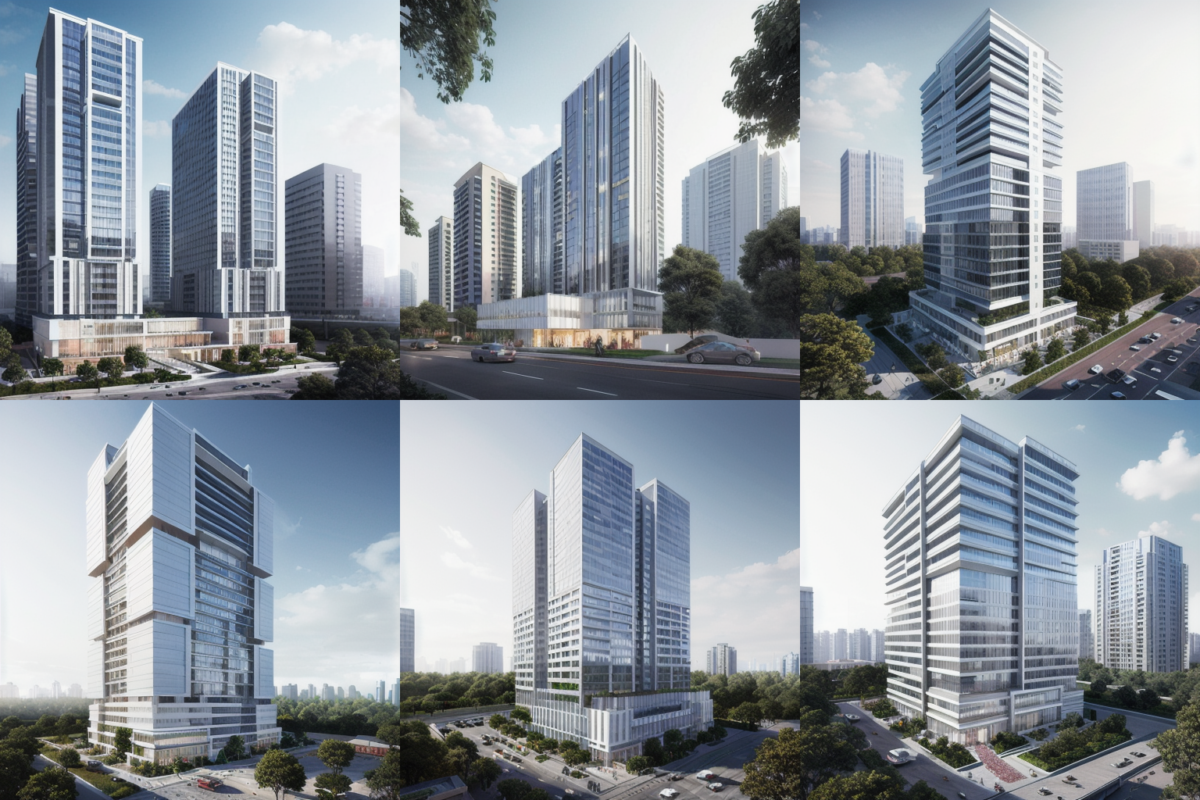The impact of the slowdown on AEC is one of the most graving within industries. The material architects work with is primarily space. So far, no tool to handle space existed, the only chance has been working only with representations of the space – various pictures of it. But a picture and a reality, it is two different things. XR allows the architects to work with space as it deserves – in space, motion, and real size – for the first time in history. And perhaps even more, the laymen – clients, authorities, the public – appreciate the chance to grasp spaces in XR perceiving and to understand the designs before implementation. A state-of-the-art XR technology [253] provides a break-through in three essential performance areas: (i) instant modeling of spaces in space and motion, real size; nothing else even remotely as good exists when it comes to conceptual designing; (ii) communication and collaboration in the scene; stakeholders can be in place or remote; (iii) seamless integration of XR and BIM environment; high visual quality of rendering of materials, surfaces, lighting, day and night, seasons of the year atmospheres is provided within the immerses into the virtual reality rendering of the BIM model. Even though however, the penetration of the technology within architectural practices and the AEC industry is still low.
On the brink of 2024, the XR field raises its head and anticipates a breakthrough. It is not only and most probably even not primarily about the famous Apple Vision Pro. As these lines are emerging, the entire rumor goes about the unprecedented quality of visual perception and (visual) control of action provided by the overpriced gadget that, however, so far lacks a sufficiently robust embedding in other than entertainment and social realm. The actual starting points are cloud solutions and (another) streaming capacity uprise, and spatial computing [327]. Merging the digital and physical realms, the concept of spatial computing is intended to allow computers to understand and interact with people more naturally in their everyday environment (which, importantly in this paper´s framework, architecture and the built environment articulate). Sensors, computer vision, and techniques like augmented reality contribute to this transformative approach [328]. Spatial computing, indeed, can be a liaison between XR and AI that was not even hoped for and that not only could channel investment flows back to XR but could bring both the technology fields to (another) take off.
Spatial computing (and the industrial metaverse) is exceptionally prone to adopt beneficially the Hawkins´/Numenta model of three-plus-dimensional spatial thinking. Practical results and implementation are still far ahead but the motivation for respective R&D is strong: from revolutionizing the ways we interact with the world around us – both the real and the not yet implemented – through abilities to drive efficiencies and improve processes. Whatever the AI applications and networks to bring architectural designing to the new level are or will be, the patterns´ retrieving and elaboration as well as generating, pre-generating for the human-in-the-loop engagement, processings´ imitating and transferring, predictive simulations, designs´ reviewing and solutions´ evaluating (not only ex-post but real-time, following state trajectories and action trajectories), or optimization criteria specifying (all the/and other concepts elaborated later in (4)) will achieve (next level of) productivity and efficiency if implemented by spatially structured computing algorithms.
Space: the essence of architecture
Along with nature, it is architecture that creates the world of human existence – a space that has three or more dimensions with diachronic, sensory and experiential, social, cultural, and other knowledge “inputs” that add to the geometric dimensions of the rooms and places we inhabit. The theory of public space puts it clearly: As soon as and only exposed in public space, a construction becomes architecture. … Architecture is a physical spatial structure created by man, lasting in a given place and resonating with the socio-cultural values of the environment, which has the nature of a public space [1].
Comprehensive spatiality is the key to understanding architecture. (In addition to being worthy of emphasis,) the fundamental spatiality of architecture is intertwined with the (above brought about) spatiality of our thinking probably more deeply than explored so far: the key may be the spatiality of diachrony, which underlies activities both in our cognition of and interaction with the world around us and in their processing in the Neocortex. In any case, today, the two are combined with the unprecedented spatiality of perception brought about by immersive XR. The processing of spatiality of thinking in AI networks and algorithms should naturally embed itself in the computational structures of XR. This will be the next level of both AI and XR; for architectural designing, this moment may be a singularity that – unlike the often futile catching up with human to date – will bring real breakthroughs that will provide the unexpected.
Nonetheless, the technological breakthrough alone will hardly be enough. An adoption of the unprecedented creative tools and possibilities by the industry will be needed. Today, architects should be truly motivated to bring their field and prefession to summum templum architecturae after decades of sidelining again [8,304]. It is time for architects to prove Rutger Bregman err when saying that the real crisis [of our times] is that we can’t come up with anything better [7].” It is time for architects to grasp the singularity given by the encounter of the trinity of three- and more-dimensional spatiality and diachrony (the term coined in the Introduction to this paper) with the acute opportunities to overcome the lasting lapse of attention to the poiétic nature of architectural creation and to employ in architecture and the built environment development not the “proven” but the state-of-the-art deep-learning strategies (as identified in the introduction to section (3) of this paper).
Design patterns: lessons that have been skipped mistakenly
Opposed to the “sky is the limit” architectures whose form is often pre-defined neither by existing neighboring structures nor by short-term financial perspectives and approaches, there are architectures – buildings designed and constructed according to given spatial conditions, terms of future usage, and strict economic templates. In fact, this is the case for the vast majority of architectures – which, nevertheless, neither diminishes their importance nor makes the role of their architects less responsible and demanding. The vast majority of what is being designed, planned, and eventually built to saturate the needs of a growing population and living standards in terms of dwelling – it is residential buildings – work, and production – from office buildings to production objects – transport and logistics – among others logistic complexes and storage facilities – and many other buildings´ typologies falls into the category of mass production and, kind of, consumer goods. Such a categorization does not challenge the contribution of the respective authors, designers, and planners in terms of “creativity used”, craft, and efforts. Many such architectures launch their way to existence in architectural competitions – formal and non-formal – and not a few of them get their “five minutes of fame” in architectural websites, magazines, and exhibitions; nevertheless, they remain a “stardust”, a sort of “no name” (except for specialist history scholars or local patriots); not to make anybody offended, let us label them “production [ones]” – production architectures and production architects. In a consequence, such architectures make the complex performance of the built environment: estimated the occurrence of the phenomenon very similarly to Chaillou [329], more than 90 % of the performance in terms of environmental impacts, sustainability, and macro economy, but also the majority of the performance in social, cultural, and economic terms. It is not the architectural icons but these production architectures that the entire population is exposed to on a day-to-day basis – at home, at work, at school, at leisure and social activities, at commuting, at going in for sports and recreational activities, and at walking pets as well as at tackling the household budgets. In terms of design and planning, the obvious richness of examples and models may balance the complexity of multiple limits and constraints that intervene in the design process; however, it does not make a creative architectural approach redundant or expendable.
Until recently, little was more overlooked in the field of AI than this opportunity and challenge – both in architectural and planning practice and in research and tools and processing standards development. Further discussed in section (5) of this paper, a vast and promising field of pattern-based AI-driven development of architectural designing reveals. Advanced reinforcement learning techniques, imitation-based learning, self-learn, and transfer learning strategies shall take over R&D in AI in architecture to concentrate not only on the input-output images´ pairings but primarily on the design development processes. AI-driven robotics shall be welcomed as the inspiration. The performance of advanced reinforcement-learning agents becomes the focal point: instead of complementarily to general models, particular studios and architects can be equipped with specific, personalized design assistants that may enhance general craft on the one hand and specific knowledge and skills on the other. Fostering, fine-tuning, and strengthening the unique capabilities and talents of particular architectural studios and individuals is an image of the future of the profession and the branch that, as a concept and in its consequences, may resist understanding and grasping today; a true, game-changing breakthrough.
Advice Whispering
Not a straightforward supervised-learned layout outputs deriving from image inputs that section (5) discusses as a dead-end but “sampling” of generative patterns = already existing solutions, selected by AI as the most suitable not only in terms of floor-plan or/and spatial solutions but in terms of structural solutions, too, and, even more importantly, learning the techniques of design development appears a key. Based on the given goal parameters and constraints, an adaptation (first human, soon AI-supported, and finally AI-driven) of selected patterns is proposed.
Moreover, both the selection and adaptation processes interweave with outcomes and adaptation solutions evaluation in terms of microclimate qualities – daylight and sunshine, or temperature stability – energy efficiency and consumption, acoustics, as well as area capacity and other qualities of the solution in process. An ability to infer the properties of the solution to which the design development is heading – whether led by a human or AI – stemming from the experience gained in learning on a set of solutions is natural to advanced AI models. The predictive inference can be available starting from the earliest phases of design – from the first sketch in terms of how a human drafts and develops a design. AI can go conveying the inference continuously in a way we can call whispering, providing the designer – human as well as AI – with comprehensive feedback on his or its design decisions and heading of the design. This way, the design will be optimized not in the mode try – error – correction – another error – another correction – and so forth till the designer is satisfied with the feedback parameters or too tired to continue trying, which is the state-of-the-art today, but continuously. The effect in terms of time and cost spent, and quality of the solution achieved is obvious and huge.
However, challenges remain: how to access the immense sum of the preceeding architectures records when a paradigm of protecting the authorship by hiding the representations of the architecture designed to the public. In this respect, the approach of the architectural community contrasts the approach of the IT developers community. Even the law contributes the „jealousy“ approach – „jealousy“ compared to the liberal approach of the IT developers community – of architects to the outputs of their work puting that an architectural drawing is an author´s work, whilst a software code is not. However, the IT developers’ community feels no disadvantage: the opposite is the reality. IT developers are used to providing each other with their achievements in widely shared libraries; Github [330], Gitlab [331], or Patternforge [332], and many others are the platforms. Who makes the profit are not only particular IT developers that can fulfill their tasks and achieve goals more quickly, with less effort, and for lower cost, whilst making available the results of their previous work costs them nothing; the whole field makes a profit developing quicklier and better, a more efficient way based on the joint efforts of all memebers of the community. The perspective of the benefit of free approach to the existing solutions – in particular parametric representations of architectures both built and only designed – appears an incentive for reconsideration current approaches in terms of architectural design – and whole AEC, too. A particular architecture is „a product“ of public space, public space is outlined by particular architectures, and public space is, as a substance, an inclusive goods that all people are entitled – and welcome! – to use. So why not to share „all architectures“, too – at least virtually.
Debunked the vision of AI replacing „the architect genius“ [306], the supreme involvement and role of a human in a creative process remains untouched or, better to say, becomes upgraded. Maybe it is not always „the genius“ – sometimes it may be rather a craftsman – but it is only his intuition, creativity – however you want to address it – that makes the authentic poiésis of architecture real. Opposed to poetic, authentic architectural creativity, the nature of design development of parametric and material aspects of architecture is mimetic – developing patterns in an imitative way by definition: it is the field for AI. The parametric aspect of architecture may become “an output” of AI; to be authentic, the poiétic aspect must always be a humn creativity issue – and consequently, the whole architecture, too. Today, architecture as an inherently comprehensive discipline is developed in teamwork as a rule. Along with the development of AI´s deployment in architecture, new roles will emerge: among others the „superuser“ tackling the AI, an architect with a strong IT background, or an IT expert with a strong architectural background. Nonetheless, the „superuser“ will replace the leading architect neither in his conceptual role nor in aesthetic respects. The „superuser“ will economize leading architect´s efforts and forces for the sake of indispensable creativity. By the way, it is about a position that renders to be not so far (though undoubtedly distinct) from today´s BIM (Building Information Management) Coordinator …
Considering the three currently emerging main task-realms for AI in architecture – patterns´ collection and choice, patterns´ processing, and patterns´ based continuous evaluation of to-date design outcomes, though not yet matured, even only sketches – a prospect for next-generation AI models, learning strategies, and (reinforcement learning) agents – apprentices reveals.








